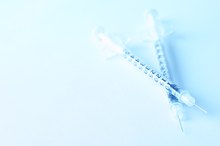FTM Breast Reduction Exercises Without Surgery
The process of transitioning from female to male typically takes a significant period of time. Transgender men may wish to significantly reduce breast size as part of this transitioning process. Gender reassignment surgery typically focuses on the breast and genital areas, altering anatomical traits from a function and aesthetic typically viewed as female to those viewed as male. Breast reduction or removal surgery is typically part of gender reassignment surgery. However, if you do not wish to undergo surgery -- or if you do not have insurance coverage to pay for such surgery -- there are nonsurgical options that may help reduce your breast size.
Weight Loss
Female breasts are made up mostly of fatty tissue, connective tissues and milk glands. Because your breasts have a higher fat content than, for example, your face or your legs, overall weight loss can reduce the size of your breasts faster than other areas of your body. The correlation between body fat proportion and breast size is one of the reasons big breasts are more commonly found on overweight women -- lean women typically have smaller breasts.
Hormone Therapy
How to Make My Breasts Smaller
Learn More
Many female-to-male transgender people use androgen hormones such as testosterone to help affect physical and other changes. If you are taking an androgen such as testosterone, this hormone may cause changes to your breast size and shape. Breasts may become smaller or more elongated. Testosterone can also cause a broadening of the shoulders, which would make your breasts look smaller by comparison. Although some people experience weight gain with androgen use, others experience overall weight loss. If you lose weight overall, your breast size will also likely decrease significantly.
- Many female-to-male transgender people use androgen hormones such as testosterone to help affect physical and other changes.
- If you are taking an androgen such as testosterone, this hormone may cause changes to your breast size and shape.
Calorie Deficit
One way you can lose weight from your body -- and therefore fat from your breasts -- is through creation of a calorie deficit. Simply put, this means that the number of calories you burn in a day will be greater than the number of calories you consume. A calorie deficit can be created by restricting how much you eat, by burning excess calories through exercise, or a combination of both. One pound of body fat contains 3,500 calories, so you can lose a pound in a week by creating a daily deficit of 500 calories -- the exercise equivalent of walking approximately five miles.
- One way you can lose weight from your body -- and therefore fat from your breasts -- is through creation of a calorie deficit.
- A calorie deficit can be created by restricting how much you eat, by burning excess calories through exercise, or a combination of both.
Considerations
Natural Ways to Reduce Male Breast Size
Learn More
Although weight loss, hormone therapy or an exercise-induced calorie deficit may lead to a reduction in the size of your breasts, none of these methods is proven to directly cause changes in breast size. Breast reduction surgery is the only certain method of making your breasts smaller. When dieting for overall weight loss, maintain a minimum safe daily calorie intake of 1,200 calories for a female or 1,800 calories for a male 2. Consult your doctor for medical advice before making significant dietary or lifestyle changes.
- Although weight loss, hormone therapy or an exercise-induced calorie deficit may lead to a reduction in the size of your breasts, none of these methods is proven to directly cause changes in breast size.
- Consult your doctor for medical advice before making significant dietary or lifestyle changes.
Related Articles
References
- Big Bust Support: Breast Reduction Exercises
- BMI Calculator: Calorie Intake to Lose Weight
- Winocour S, Lemaine V. Hypoplastic Breast Anomalies in the Female Adolescent Breast. Semin Plast Surg. 2013;27(1):42–48. doi:10.1055/s-0033-1343996
- Cruz NI. Breast Asymmetry in Women Requesting Plastic Surgery of the Breast. P R Health Sci J. 2018;37(4):230‐238.
- Chen JH, Chan S, Yeh DC, Fwu PT, Lin M, Su MY. Response of bilateral breasts to the endogenous hormonal fluctuation in a menstrual cycle evaluated using 3D MRI. Magn Reson Imaging. 2013;31(4):538-44. doi:10.1016/j.mri.2012.10.022
- Kader T, Hill P, Rakha EA, Campbell IG, Gorringe KL. Atypical ductal hyperplasia: update on diagnosis, management, and molecular landscape. Breast Cancer Res. 2018;20(1):39. doi:10.1186/s13058-018-0967-1
- Hisham A. Juvenile Breast Hypertrophy: A Successful Breast Reduction of 14.9% Body Weight without Recurrence in a 5-Year Follow-Up. Case Rep Surg. Volume 2017, Article ID 3491012. doi:10.1155/2017/3491012
- Kayar R, Çilengiroğlu ÖV. Breast Volume Asymmetry Value, Ratio, and Cancer Risk. Breast Cancer (Auckl). 2015;9:87-92. doi:10.4137/BCBCR.S32789
- Reilley Ann F. Breast Asymmetry: Classification and Management. Aesthetic Surg J. 2006;26(5):596-600. doi:10.1016/j.asj.2006.07.006
- Cruz NI. Breast Asymmetry in Women Requesting Plastic Surgery of the Breast. PR Health Sci J. 2018 Dec;37(4):230-238.
Writer Bio
Jae Allen has been a writer since 1999, with articles published in "The Hub," "Innocent Words" and "Rhythm." She has worked as a medical writer, paralegal, veterinary assistant, stage manager, session musician, ghostwriter and university professor. Allen specializes in travel, health/fitness, animals and other topics.









